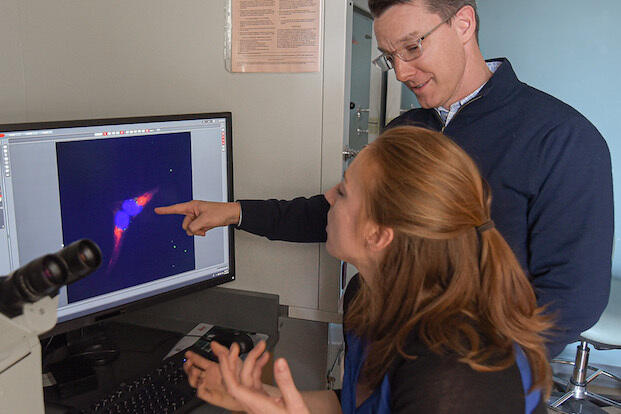
Sept. 8, 2020
A VCU researcher’s work is shedding light on a deadly disease
Share this story
More than 1 million people each year contract scrub typhus, a bacterial disease transmitted through bites from infected chiggers. Although the infectious disease, which can have a fatality rate as high as 70%, is most common in the Asia-Pacific region, recent appearances in populations outside of that area indicate that scrub typhus is more of an international health concern than originally thought.
Scrub typhus still has no preventive vaccine, but thanks to the work of Jason A. Carlyon, Ph.D., a professor in the Department of Microbiology and Immunology at the Virginia Commonwealth University School of Medicine, more is known about the cause of the disease than ever before, and a vaccine might finally be within reach.
Carlyon, who earned his bachelor’s degree in biology from the College of Humanities and Sciences and his Ph.D. from the School of Medicine, returned to his alma mater as an assistant professor in 2007. He studies rickettsial diseases, or diseases caused from bacteria that are transmitted by biting arthropods such as ticks or chiggers. In the case of scrub typhus, Carlyon’s lab has narrowed in on how the disease’s pathogen, a bacterium called Orientia tsutsugamushi, invades human cells and avoids detection by the immune system.
“We’re interested in how Orientia does the things it has to do to survive,” Carlyon said. “How is it able to impair our immune response? What does it do to counteract our immune defenses? What does it have to do to obtain nutrition from our cells in order to survive and cause disease? The idea is that, now that we better understand these concepts, we can begin to work toward a protective vaccine against it.”

A better understanding of how one pathogen operates, Carlyon adds, can often lead to advancements in treatments for other infectious diseases.
“Essentially, if you can understand what any intracellular pathogen does at the molecular level to be successful, you can see how it’s applicable to other pathogens and use that knowledge to identify new targets for treatment or intervention for those diseases as well,” he said. “Ultimately, we want to have pragmatic and translational outcomes that are going to be beneficial to patients, but I think it’s equally important to contribute to a larger body of knowledge that can have a lot of indirect benefits.”
Carlyon’s research has come a long way since he first began studying Orientia tsutsugamushi in 2010 as part of the inaugural cohort of Blick scholars at VCU. The four-year scholar program, which aims to advance the research of junior faculty members from the university’s health sciences schools, comes with an annual award from the George and Lavinia Blick Research Fund.
“When I became a Blick scholar, I had spent the previous 12 years of my career studying another rickettsial disease, with goals similar to those I’ve had studying scrub typhus,” Carlyon said. “I became aware of how little was known about the fundamental molecular pathogenesis of scrub typhus and saw an opportunity and a need for someone to study it.”
Over his four years as a Blick scholar, Carlyon received about $50,000 to support his research. That funding, he said, helped him secure the equipment and personnel needed to establish a new research program in the School of Medicine to study Orientia tsutsugamushi.
We’re interested in how Orientia does the things it has to do to survive. How is it able to impair our immune response? … What does it have to do to obtain nutrition from our cells in order to survive and cause disease? The idea is that, now that we better understand these concepts, we can begin to work toward a protective vaccine against it.
Discoveries made in Carlyon’s lab have since earned the program more than $3 million in grant funding from the National Institutes of Health and other external sources.
“After that initial funding, we just steadily built the program, getting one grant after another as we continued to generate more and more data and build a line of research that we could pursue long term,” said Carlyon, who was appointed an American Academy of Microbiology fellow in 2019 for his outstanding contributions and achievements in microbiology. “Here we are nearly a decade — and over $3 million in funding — later, and all the discoveries that we’ve made trace back to getting that initial support from the Blick funding.”
Receiving the Blick scholar award early in his career at VCU felt like recognition for what he had already accomplished, Carlyon said. It also serves as an affirmation that he was on the right track.
“Knowing that the university supported the vision that I had for foraying into this new area of research was a boost of confidence,” he said. “That kind of recognition shows that the university believes in you, and that’s really important.”
A longer version of this story originally appeared in Impact magazine under the headline “Sowing the seeds.”
Subscribe to VCU News
Subscribe to VCU News at newsletter.vcu.edu and receive a selection of stories, videos, photos, news clips and event listings in your inbox.







